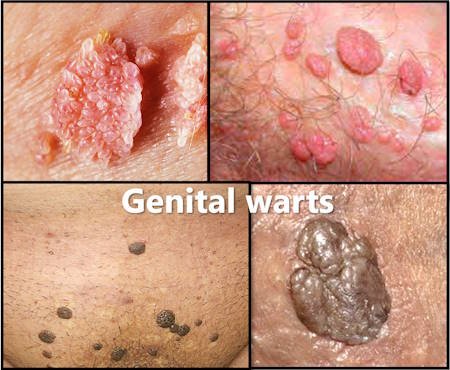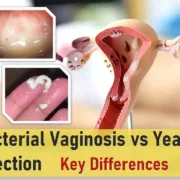Genital Warts (HPV) Vs. Skin Tags: What’s the Difference?
Introduction
Genital warts and skin tags are common skin conditions that can appear on various parts of the body, including the genital area. Although they may look similar, these conditions have different causes, risks, and treatment options. Understanding these differences is crucial for accurate diagnosis and appropriate management. This article provides a detailed comparison of genital warts and skin tags, focusing on their characteristics, differences, treatment options, and prognosis.
 What Are Genital Warts?
What Are Genital Warts?
Genital warts are growths that appear on the genital or anal area, caused by the human papillomavirus (HPV). HPV is one of the most common sexually transmitted infections (STIs) globally. Genital warts can be flat or raised and may have a rough, cauliflower-like texture. They are usually the color of the skin but can sometimes be darker. Because they are contagious, genital warts can be spread through sexual contact, making them a significant concern for sexually active individuals. For more details about Human Papillomavirus (HPV) Infection read “Human Papillomavirus (HPV) Infection: Symptoms and Prevention”
What Are Skin Tags?
Skin tags are small, soft growths that hang off the skin, often found in areas where the skin folds, such as the neck, armpits, groin, and under the breasts. Unlike genital warts, skin tags are not caused by a virus and are not contagious. They are usually flesh-colored or slightly darker and can vary in size. Skin tags are benign and generally harmless, although they can become irritated if they are constantly rubbed or pulled by clothing or jewelry. For more details about Skin Tags read “What are Skin Tags and Everything About Skin Tag Removal”
Genital Warts Vs. Skin Tags: What Are the Differences?
1. Cause
- Genital Warts. Caused by the human papillomavirus (HPV), specifically strains 6 and 11, which are sexually transmitted.
- Skin Tags. Not caused by a virus. They are generally associated with friction, obesity, diabetes, pregnancy, and aging.

2. Appearance
- Genital Warts. Tend to be rough, hard, and bumpy, often resembling cauliflower. They are flat or raised with a broader base and are firmly attached to the skin.
- Skin Tags. Soft to the touch, with a smoother appearance. They typically hang from the skin by a thin stalk and resemble a deflated balloon on a stalk.
3. Contagion
- Genital Warts. Contagious and can be transmitted through sexual contact. They can spread to adjacent areas of the skin, especially through scratching or shaving.
- Skin Tags. Not contagious. They cannot be spread from one person to another and are not related to any viral infection.
4. Location
- Genital Warts. Specifically affect the genital and anal areas, as well as areas of the skin exposed during sexual contact, such as the pubic area, the shaft of the penis, and around the anus.
- Skin Tags. Can appear in any area where the skin folds, such as the neck, armpits, under the breasts, and groin creases. They are often found in areas with frequent friction.
5. Growth Pattern
- Genital Warts. Can appear in clusters due to their contagious nature. They spread easily to adjacent skin areas through scratching or shaving.
- Skin Tags. Usually occur as solitary growths, often separated by normal skin. They do not spread in clusters and can appear in different parts of the body simultaneously.
6. Texture
- Genital Warts. Hard to the touch with a rough and bumpy surface, similar to cauliflower. They are not easily movable due to their broader base.
- Skin Tags. Very soft to the touch, with a thinner base and a larger top. They can bend easily due to their fragile attachment to the skin.
7. Color
- Genital Warts. Typically the color of the skin, though they can occasionally be darker.
- Skin Tags. Can vary in color—sometimes matching the patient’s skin, but often appearing lighter or darker. Their color may change over time but is not a cause for concern.
8. Growth Over Time
- Genital Warts. Slow-growing lesions that may take weeks to months to appear after infection. They may grow larger over time and spread to nearby skin. They can also eventually shrink and disappear as the immune system clears the infection.
- Skin Tags. Grow rapidly initially, but eventually stop growing. They persist until they are torn off or removed and may change color over time.
9. Age of Onset
- Genital Warts. More common in sexually active individuals, particularly those in younger age groups with multiple partners.
- Skin Tags. More common in individuals over the age of 30, with the likelihood of developing skin tags increasing with age.
10. Prevalence
- Genital Warts. Affects a significant portion of the population, with an estimated 85% of sexually active individuals contracting HPV at some point in their lives.
- Skin Tags. Less common than genital warts, affecting about 5% of the population.
11. Genetic Predisposition
- Genital Warts. No genetic predisposition; anyone can contract genital warts through direct contact with infected skin.
- Skin Tags. Some people have a genetic predisposition to developing skin tags, especially if they have a family history of them.
12. Contextual Factors for Diagnosis.
- Genital Warts. The diagnosis can be influenced by factors such as the patient’s sexual history, the growth’s location, and the time it takes for the warts to appear after infection.
- Skin Tags. Diagnosis may involve considering the patient’s age, the growth’s location, and any conditions that predispose them to skin tags, such as obesity or diabetes.
Treatment for Genital Warts
Treatment for genital warts aims to reduce symptoms, prevent the spread of the virus, and remove visible warts. Common treatment methods include.
- Cryotherapy. Freezing the warts with liquid nitrogen to destroy them.
- Surgical Removal. Cutting off the warts using a scalpel or scissors in a minor procedure.
- Laser Therapy. Burning away the warts with a focused laser beam.
- Topical Treatments. Applying prescription creams or acids, such as trichloroacetic acid (TCA), to destroy the warts.
While these treatments can remove warts, they do not cure the underlying HPV infection, so warts may recur.
Outcomes and Prognosis
For individuals with genital warts, the prognosis varies. Warts may recur after treatment, and the HPV infection may persist in the body. However, many people eventually clear the infection naturally over time.
Skin tags, once removed, typically do not return in the same spot, although new tags may develop in other areas. Both conditions are generally benign and not life-threatening.
Frequently Asked Questions (FAQs)
Can genital warts be prevented?
Yes, vaccination against HPV can significantly reduce the risk of developing genital warts. Using condoms during sex can also lower the risk, although it does not completely eliminate it.
Are skin tags dangerous?
No, skin tags are benign and generally do not pose any health risks. They can be removed if they become bothersome.
Can genital warts turn into cancer?
Certain strains of HPV are associated with a higher risk of cancers, such as cervical cancer. However, the strains that cause genital warts (HPV 6 and 11) are typically not linked to cancer.
Is it necessary to treat skin tags?
Treatment is not necessary unless the skin tags are causing discomfort or irritation. Many people choose to remove them for cosmetic reasons.
Can genital warts clear up on their own?
Yes, in some cases, genital warts may disappear on their own as the immune system fights off the HPV infection. However, treatment can help speed up this process and prevent the spread of warts.
Conclusion
Distinguishing between genital warts and skin tags is crucial for proper diagnosis and management. While genital warts are a contagious, sexually transmitted condition caused by HPV, skin tags are benign growths that pose no risk of contagion. Understanding these differences can help individuals seek the right care and avoid unnecessary concerns. Always consult a healthcare provider for an accurate diagnosis and tailored treatment plan.










